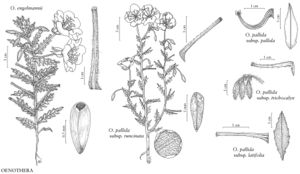Difference between revisions of "Oenothera pallida subsp. runcinata"
N. Amer. Fl., ser. 2, 5: 119. 1965.
imported>Volume Importer |
imported>Volume Importer |
||
| Line 104: | Line 104: | ||
|publication year=1965 | |publication year=1965 | ||
|special status= | |special status= | ||
| − | |source xml=https://xjsachs2@bitbucket.org/aafc-mbb/fna-data-curation.git/src/ | + | |source xml=https://xjsachs2@bitbucket.org/aafc-mbb/fna-data-curation.git/src/e39f0e846f172941159b2045254d62d10d9823f6/coarse_grained_fna_xml/V10/V10_134.xml |
|subfamily=Onagraceae subfam. Onagroideae | |subfamily=Onagraceae subfam. Onagroideae | ||
|tribe=Onagraceae tribe Onagreae | |tribe=Onagraceae tribe Onagreae | ||
Latest revision as of 10:31, 9 May 2022
Herbs perennial, strigillose, sometimes also sparsely villous, or glabrous; from a taproot, lateral roots producing adventitious shoots. Stems usually branched throughout. Leaves: rosette not present at anthesis, 2–3.5(–5) × 0.4–1(–1.5) cm; blade oblong to narrowly lanceolate, margins usually deeply sinuate-dentate to pinnatifid, rarely dentate only. Flowers: buds with free tips 0–0.2 mm; floral tube 15–30 mm; sepals 10–25 mm; petals 10–30 mm. Capsules spreading to reflexed, straight or curved, sometimes contorted. 2n = 14.
Phenology: Flowering (Apr–)May–Sep.
Habitat: Sandy soil, dunes, disturbed areas, alkaline soil, pinyon-juniper woodlands, shrublands with Artemisia, Ericameria, or Prosopis, open ponderosa pine woodlands.
Elevation: 1100–2400 m.
Distribution
Ariz., Colo., N.Mex., Tex., Utah, Mexico (Chihuahua).
Discussion
Subspecies runcinata replaces subsp. pallida in the southern part of the species range. In New Mexico, it is most morphologically diverse, with plants with subentire leaves densely strigillose recognized in the past as subsp. gypsophila. The distribution and characteristics of these plants should be studied more in relation to other types of populations included in subsp. runcinata. Glabrous plants in the southern portion of the range of subsp. runcinata, especially in New Mexico, adjacent Texas, and Chihuahua, Mexico, have been recognized as var. brevifolia.
Selected References
None.
